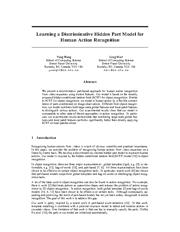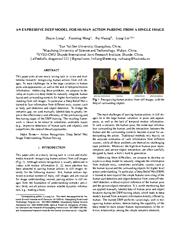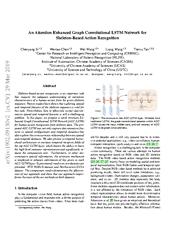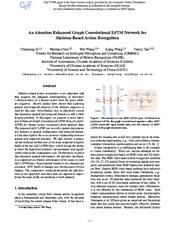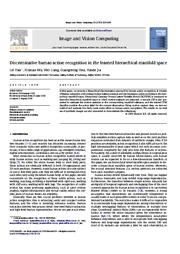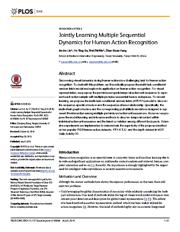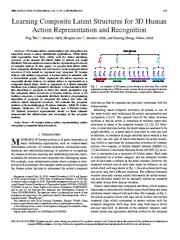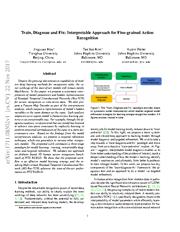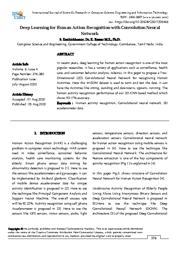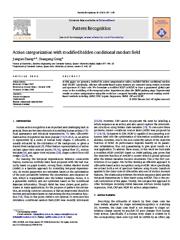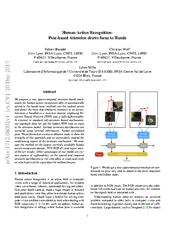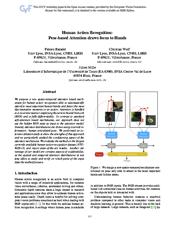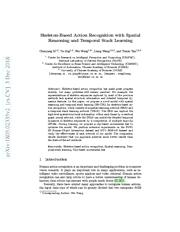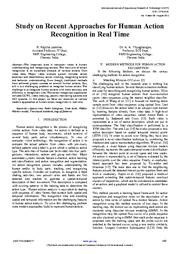A copy of this work was available on the public web and has been preserved in the Wayback Machine. The capture dates from 2022; you can also visit the original URL.
The file type is application/pdf.
Filters
Learning a discriminative hidden part model for human action recognition
2008
Neural Information Processing Systems
We present a discriminative part-based approach for human action recognition from video sequences using motion features. ...
Similar to hCRF for object recognition, we model a human action by a flexible constellation of parts conditioned on image observations. ...
Conclusion We have presented a discriminatively learned part model for human action recognition. Unlike previous work [10] , our model does not require manual specification of the parts. ...
dblp:conf/nips/WangM08
fatcat:hx6scdnkqrdoddgvi2khul2d74
An expressive deep model for human action parsing from a single image
2014
2014 IEEE International Conference on Multimedia and Expo (ICME)
Addressing these problems, we propose to develop an expressive deep model to naturally integrate human layout and surrounding contexts for higher level action understanding from still images. ...
In particular, a Deep Belief Net is trained to fuse information from different noisy sources such as body part detection and object detection. ...
Rectenly, [6] proposed a new Expanded Parts Model (EPM) for human analysis. The model learns a collection of discriminative templates which can appear at specific scale-space positions. ...
doi:10.1109/icme.2014.6890158
dblp:conf/icmcs/LiangWHL14
fatcat:k6lvbo2uhzfsnkpmgdep3qdtwy
An Attention Enhanced Graph Convolutional LSTM Network for Skeleton-Based Action Recognition
[article]
2019
arXiv
pre-print
In this paper, we propose a novel Attention Enhanced Graph Convolutional LSTM Network (AGC-LSTM) for human action recognition from skeleton data. ...
Skeleton-based action recognition is an important task that requires the adequate understanding of movement characteristics of a human action from the given skeleton sequence. ...
The works in [39, 26, 14, 22] further show that learning discriminative spatial and temporal features is the key element for human action recognition. ...
arXiv:1902.09130v2
fatcat:v5my74xbsbcbbes5vnxhgellie
An Attention Enhanced Graph Convolutional LSTM Network for Skeleton-Based Action Recognition
2019
2019 IEEE/CVF Conference on Computer Vision and Pattern Recognition (CVPR)
In this paper, we propose a novel Attention Enhanced Graph Convolutional LSTM Network (AGC-LSTM) for human action recognition from skeleton data. ...
Skeleton-based action recognition is an important task that requires the adequate understanding of movement characteristics of a human action from the given skeleton sequence. ...
The works in [39, 26, 14, 22] further show that learning discriminative spatial and temporal features is the key element for human action recognition. ...
doi:10.1109/cvpr.2019.00132
dblp:conf/cvpr/SiC0WT19
fatcat:ekfyg3lah5b5hnkwh7opqw4rbq
Discriminative human action recognition in the learned hierarchical manifold space
2010
Image and Vision Computing
In this paper, we propose a hierarchical discriminative approach for human action recognition. ...
Using motion capture data, we test our method and evaluate how body parts make effect on human action recognition. ...
One of the most common approaches for human action recognition is to use Hidden Markov Model (HMM) or its variants [7, 8] . ...
doi:10.1016/j.imavis.2009.08.003
fatcat:md2eopwzdnegfdkzcri74mmgjq
Jointly Learning Multiple Sequential Dynamics for Human Action Recognition
2015
PLoS ONE
Discovering visual dynamics during human actions is a challenging task for human action recognition. ...
To deal with this problem, we theoretically propose the multi-task conditional random fields model and explore its application on human action recognition. ...
Acknowledgments This work was supported in part by the National Natural Science Foundation of China (61472275, 61170239), the Tianjin Research Program of Application Foundation and Advanced Technology ...
doi:10.1371/journal.pone.0130884
pmid:26147979
pmcid:PMC4493153
fatcat:3hpgn46ddzbgbewjuuqy2rhlbu
Learning Composite Latent Structures for 3D Human Action Representation and Recognition
2019
IEEE transactions on multimedia
A discriminative EMlike algorithm is proposed to learn the model parameters and the composite latent structures of human actions. ...
A human action is modeled with a hierarchical graph, which represents the action sequence as sequential atomic actions. ...
Second, it adopts a discriminative EM-like method to learn the composite latent structures. It can mine discriminative information and features for action recognition.
B. ...
doi:10.1109/tmm.2019.2897902
fatcat:w3huj736ijbnljyzf25q23nnoi
Train, Diagnose and Fix: Interpretable Approach for Fine-grained Action Recognition
[article]
2017
arXiv
pre-print
In this paper, we propose a systematic interpretation of model parameters and hidden representations of Residual Temporal Convolutional Networks (Res-TCN) for action recognition in time-series data. ...
We validate our approach on skeleton based 3D human action recognition benchmark of NTU RGB+D. ...
The proposed Res-TCN also learns both spatial and temporal attention for human action recognition. ...
arXiv:1711.08502v1
fatcat:444awjzlz5dctalh3xikqdpise
Deep Learning for Human Action Recognition with Convolution Neural Network
2020
International Journal of Scientific Research in Computer Science Engineering and Information Technology
In recent years, deep learning for human action recognition is one of the most popular researches. ...
In this paper to propose a Two-Dimensional (2D) Convolutional Neural Network for recognizing Human Activities. Here the WISDM dataset is used to tarin and test the data. ...
Limitations will be here discrimination between the body parts which are not observable in binary silhouettes. 3D Convolutional neural networks for human action recognition are proposed in [14]. ...
doi:10.32628/cseit206466
fatcat:zk5ge4ne2zfxtj6al2lkdolapu
Action categorization with modified hidden conditional random field
2010
Pattern Recognition
In this paper, we present a method for action categorization with a modified hidden conditional random field (HCRF). ...
We formulate a modified HCRF (mHCRF) to have a guaranteed global optimum in the modelling of the temporal action dependencies after the HMM pathing stage. ...
It is worth noting that another line of research in motion action recognition is based on human parts [16] . ...
doi:10.1016/j.patcog.2009.05.015
fatcat:d5vrjig5c5fgjcyveuql3i7bzy
Human Action Recognition: Pose-based Attention draws focus to Hands
[article]
2017
arXiv
pre-print
We propose a new spatio-temporal attention based mechanism for human action recognition able to automatically attend to the hands most involved into the studied action and detect the most discriminative ...
We evaluate the method on the largest currently available human action recognition dataset, NTU-RGB+D, and report state-of-the-art results. ...
We propose a method for human action recognition, which addresses this problem by handling raw RGB input in a novel way. ...
arXiv:1712.08002v1
fatcat:tua5ck5rhrgofmp6r33iesdrp4
Human Action Recognition: Pose-Based Attention Draws Focus to Hands
2017
2017 IEEE International Conference on Computer Vision Workshops (ICCVW)
We propose a new spatio-temporal attention based mechanism for human action recognition able to automatically attend to most important human hands and detect the most discriminative moments in an action ...
We evaluate the method on the largest currently available human action recognition dataset, NTU-RGB+D, and report state-of-the-art results. ...
We propose a method for human action recognition, which addresses this problem by handling raw RGB input in a novel way. ...
doi:10.1109/iccvw.2017.77
dblp:conf/iccvw/Baradel0M17
fatcat:4or2v2e3njemvfzyztqljuag7a
Skeleton-Based Action Recognition with Spatial Reasoning and Temporal Stack Learning
[article]
2018
arXiv
pre-print
In this paper, we propose a novel model with spatial reasoning and temporal stack learning (SR-TSL) for skeleton based action recognition, which consists of a spatial reasoning network (SRN) and a temporal ...
Skeleton-based action recognition has made great progress recently, but many problems still remain unsolved. ...
Model Architecture In this paper, we propose an effective model for skeleton-based action recognition, which contains a spatial reasoning network and a temporal stack learning network. ...
arXiv:1805.02335v2
fatcat:m5ed3s4ckncnroimm54lbijbna
Study on Recent Approaches for Human Action Recognition in Real Time
2015
International Journal of Engineering Research and
Even though, traditional methods have achieved greater success on several human actions. But, still it is a challenging problem to recognize human action. ...
The challenge is to recognize human actions with more accuracy and efficiency in recognition time. ...
MODERN METHODS FOR HUMAN ACTION RECOGNITION In the following Sections, we discuss the various challenging methods for action recognition
A. ...
doi:10.17577/ijertv4is080577
fatcat:hikmv56t6jc5la7ipcny5u4kha
Interpretable 3D Human Action Analysis with Temporal Convolutional Networks
[article]
2017
arXiv
pre-print
The discriminative power of modern deep learning models for 3D human action recognition is growing ever so potent. ...
for 3D human action recognition. ...
The work of [36] leverages on similar intuition that co-occurrence of joints is a strong discriminative feature for human action recognition. ...
arXiv:1704.04516v1
fatcat:icenaac6qndqjlpstvjqrc7s6u
« Previous
Showing results 1 — 15 out of 53,312 results

